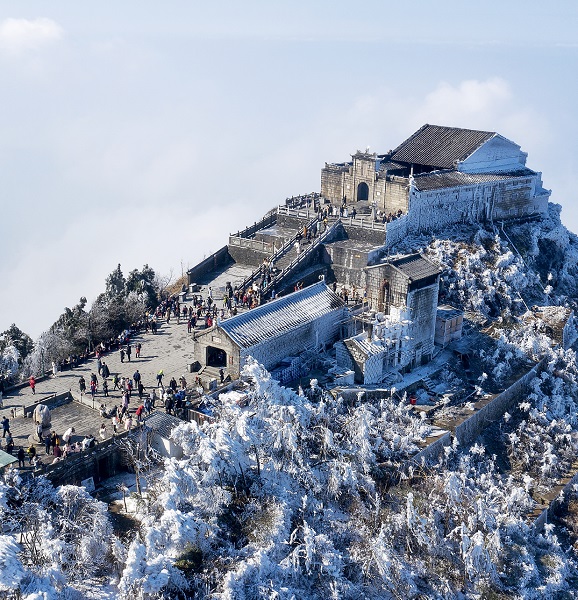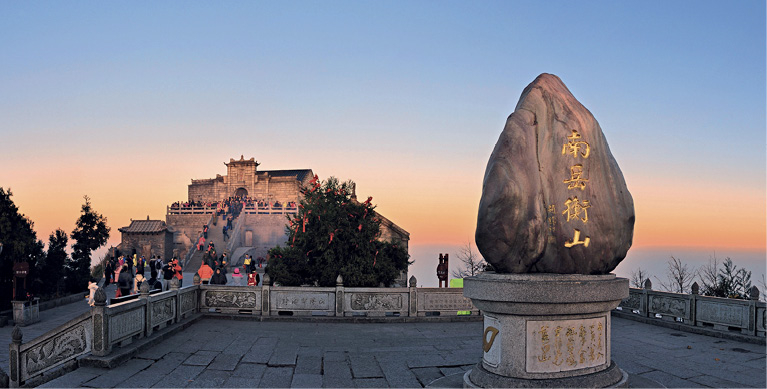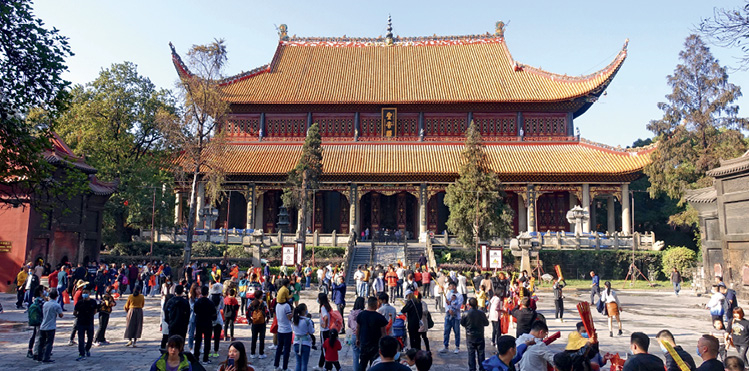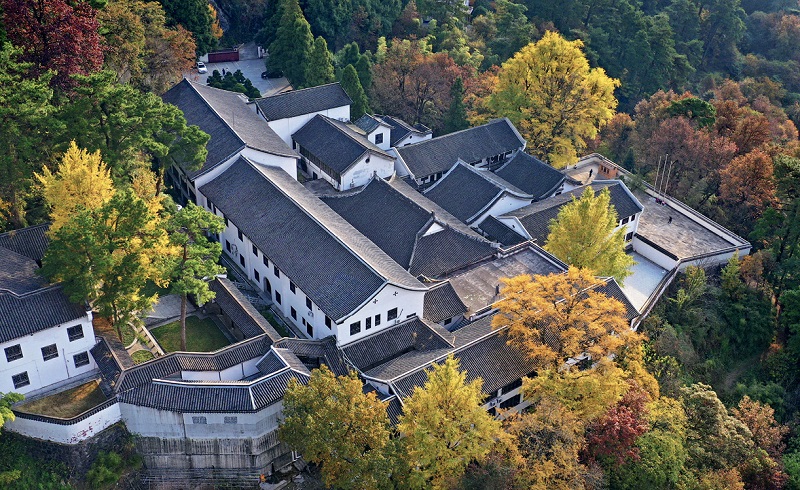At Mount Hengshan, visitors can not only wander through beautiful landscape, but also roam through historical sites and experience the charm of ancient humanity.

Trees on the Zhurong Peak at Mount Hengshan Scenic Area are covered with snow on December 5, 2020.
Mount Hengshan is often referred to as the Southern Mountain (Nan Yue) of the Five Sacred Mountains of Taoism in China. The Zhurong Peak is the tallest of its 72 peaks located in the Nanyue District of Hengyang City in Hunan Province. Its majestic landscape and diverse biodiversity have made it one of the first 5A national tourist attractions and a national nature reserve.
Mount Hengshan boasts an array of natural beauty, and the scenery varies in each season throughout the year: unique flowers bloom in spring, seas of clouds roll through the sky in the summer, sunrises are especially stunning in autumn, and the white carpets of snowfall come in the winter.
The core scenic area of Mount Hengshan has a forest coverage rate of over 91 percent. There are more than 600 families and 1,700 species of trees here, including more than 90 under state protection, such as the ginkgo tree and dawn redwood. The region is also home to rare wild animals such as the golden pheasant and pangolin, making it a natural biodiversity hub.
In addition to this, this area has also been a base of cultural activities for a long time. People began to call it the Southern Mountain during the Spring and Autumn Period and the Warring States Period (770-221 B.C.). The earliest reference to Mount Hengshan is found in the early Han Dynasty’s Erya (Literary Expositor), which is the first surviving Chinese dictionary. Mount Hengshan was a significant place in ancient times where many emperors sent envoys or paid their respects in person. Rulers such as Emperor Huizong (1082-1135) of the Song Dynasty and Emperor Kangxi (1654-1722) of the Qing Dynasty were even inspired to write poems about it.

A group of tourists enjoying a peaceful morning on the top of Mount Hengshan.
Zhurong Peak
Legend has it that the Yellow Emperor appointed Zhu Rong to take charge of the southern affairs of his kingdom as the god of fire. With fire, Zhu Rong taught the local residents how to keep warm, to cook food, and to drive away wild animals. In an effort to commemorate this god, people named the highest peak of Mount Hengshan after his name.
The Zhurong Peak is the highest peak within the mountain range of Mount Hengshan. Naturally, it is the best place to see the sunrise, watch the sea of clouds, and enjoy snowy scenery in the surrounding area.
At the foot of the peak, there is a stone staircase leading to the top of the mountain, and half way up lies a Sun View Platform, which is an ideal spot to see sunrises. Then, at the top is the famous Zhurong Hall. The walls of this temple are made of granite and its roof is covered with rows of iron tiles which are 70 cm in length, 30 cm in width, and 15 kg in weight. Among those tiles, there are a dozen made in the Song Dynasty (920-1279). What ingenuity the architects must have had to choose iron tiles that would ensure the roof survived the extreme elements that frequent the top of the peak. According to The Southern Mountain Record, a historical text written during the Qing Dynasty (1644-1911), “The purpose of those iron tiles is to protect the roof from the wind as well as ice and snow.” The Chinese characters “Zhurong Peak” that are engraved on the temple imply that the temple has integrated with the peak and become part of it.
On the west side of the temple is the Moon Watching Altar, the highest point of Mount Hengshan. During the daytime, tourists can enjoy a panoramic view of the surrounding scenery. Then after sunset, when there are clear skies, this place turns into a hot spot for viewing the moon.
Water Curtain Cave
The Water Curtain Cave is located under the Zigai Peak. Here, bubbling springs together with flying waterfalls create a harmony of nature’s majestic sounds, and then together with the light and shadows make the Water Curtain Cave known as one of the “Four Wonders” of Mount Hengshan.
The signature building of this area is a stone arch bridge inscribed with three gilt Chinese characters “Water Curtain Cave.” The bridge is supported by two three-meter-high alabaster pillars engraved with designs of flying dragons. Water flows under the dragons and converges into the Dragon Mouth Lake in front of the bridge. After walking past the lake, there is a huge cliff, on which a mysterious trail of cattle footprints can be observed. Folklore says that the marks were made by a gold bull that lives at the bottom of the pool when it stepped on the slope, trying to drive away a dragon during a fight.
Further up from the bull footprints, there is another iconic attraction — the waterfall of the Water Curtain Cave. The waterfall is more than 50 meters high, having the appearance of a huge white curtain hanging from the steep cliff, making a thunderous sound. The stone wall near the waterfall is inscribed with the words “Summer Snow and Clear Day Thunder,” which is a vivid description of the waterfall. Throughout history, a number of literati have been mesmerized by the picturesque scenery of the cave, and have left behind many popular poetic verses in honor of it. If visitors want to get a whole view of the beauty of the waterfall from a high place, they can go to Xuelang Pavilion on the opposite cliff, which was first built in the Tang Dynasty (618-907) and then renovated in the Qing Dynasty. Standing in the pavilion, people can enjoy a panoramic view of the waterfall and the cave hidden behind it.

Groups of tourists are walking through Nanyue Great Temple on October 25, 2020.
Nanyue Great Temple
The Nanyue Great Temple is the largest ancient architectural complex in southern China that harmonizes Confucianism, Buddhism, and Taoism in one temple. With a magnificent scale and exquisite architecture, it is seen as the largest museum of traditional Chinese culture and a temple of exquisite art in the south part of China.
The Nanyue Great Temple is located on the Chidi Peak. It has four major courtyards, covering an area of 120,000 square meters. The temple was originally built on the Zhurong Peak, but later moved to the bottom of the mountain during the Sui Dynasty (581-618) for the convenience of imperial rituals and folk pilgrimages. The buildings on the central axis of the temple were built in a royal architectural style, which served as an important place for worship and pilgrimage.
A number of works of art can be found here. For example, there is a marble dragon engraved on the 16 stone steps leading up to the main hall. And a 4.55-meter tall, 500-kilogram bronze calabash tower in the center of the ridge of the main hall with a one-meter-long, 150-kilogram bronze sword placed at each end of the ridge. They are not only used for blessing and decoration, but have also been recognized by many experts in architecture and metallurgy as having the function of lightning rods.
There are 72 stone pillars inside and outside the main hall, symbolizing the 72 peaks of Hengshan. The two in front of the main gate are chiseled from one block of granite, with a height of six meters, a diameter of one meter, and a weight of 14 tonnes. Those pillars are stacked with wooden beams, painted with lacquer, and connected by bucket arches. The hall is decorated with various types of wood carvings and stone and clay sculptures from top to bottom. Many depict ancient tales such as Shennong Tastes Hundreds of Herbs and Yu the Great Taming the Flood. On the shrine in the center of the main hall sits the majestic 6.3-meter-tall fire god Zhu Rong, looking like a formidable guardian of the mountain.
The number, variety, and skill of the wood carvings, stone carvings and clay sculptures found in the Nanyue Great Temple are amazing, reflecting the exquisite skills and wisdom of ancient people.

An aerial view of the Fuyan Temple at Mount Hengshan surrounded by tinted vegetation in autumn on November 24, 2019.
Rich History and Culture
Mount Hengshan is not only a famous mountain home to majestic scenery, but also a sacred historical and cultural mountain. In this place, Taoism and Buddhism coexist and complement each other. Taoism practicing started here during the late Eastern Han Dynasty (25-220), and Buddhism took root as early as the Southern Dynasty (420-589). Religious culture has been accumulating and expanding here for more than 1,000 years. In particular, the coexistence of Taoism and Buddhism in one temple on one mountain is rare in China and the world.
Here, the culture of ancient academies began during the Tang Dynasty, when an emperor built the Nanyue Academy in honor of his famous chancellor. During the Guangxu period of the Qing Dynasty, there were 17 academies in the present Nangyue District, making it the largest academy hub in China. Since the Tang Dynasty, many literati, politicians, and scholars have visited the region, including great poets Li Bai and Du Fu, and left numerous poems, songs, cliff carvings, and historical relics behind.
Mount Hengshan is aslo respected for its monumental example in the history of fighting against fascism.
There was a guerrilla official training campus in this area, cofounded by the Natoinalist Party of China and the Communist Party of China. More than 3,000 guerrilla leaders received training there. There is also a martyrs cemetery in the area, which is the earliest and largest anti-Japanese martyrs’ memorial cemetery in China.